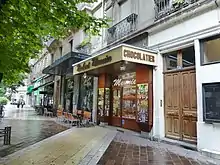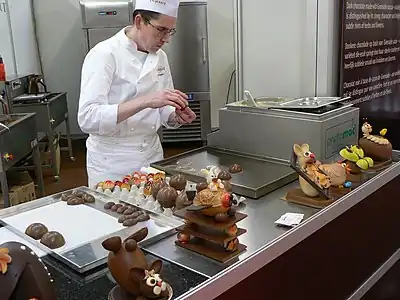


A chocolatier (/ˌtʃɒkələˈtɪər, ˈtʃɒkələtɪər/ CHOK-əl-ə-TEER, -teer, UK also /ˌtʃɒkəˈlætɪər/ CHOK-ə-LAT-eer, French: [ʃɔkɔlatje] ⓘ) is a person or company who makes confectioneries from chocolate. Chocolatiers are distinct from chocolate makers, who create chocolate from cacao beans and other ingredients. They are pastry chefs or confectioners who specialize in chocolate and making chocolate candies. Chocolatiers work artisanally with ready-made chocolate mass and are therefore distinct from industrial chocolate makers.
In the food industry, it is mostly food technologists or food technology engineers (FH) who deal with the development and further development of chocolate products in large, well-known chocolate brands. For the industrial production of chocolate and chocolate products, a three-year training course has been set up in Germany to train people as specialists in confectionery technology.[1] The Central Technical School of the German Confectionery Industry (ZDS) in Solingen offers further education and training.[2]
Education and training
Traditionally, chocolatiers, especially in Europe, are trained through an apprenticeship with other chocolatiers. It is now common for chocolatiers to start out as pastry or confectionery chefs, or attend culinary training specifically for working with chocolate. Being a master chocolatier involves perfecting the art of working with chocolate to create desserts as well as skillfully creating pieces of art with chocolate. Chocolatiers must understand the physical and chemical aspects of chocolate, to not only create chocolates and other confections, but also to create sculptures and centrepieces. Perfecting the technical aspects of design and developing the art of flavor takes many years of practice.[3]
Culinary schools
There are a variety of culinary schools and specialty chocolate schools, including the Ecole Chocolat Professional School of Chocolate Arts in Canada,[4] and The Chocolate Academy by Callebaut, with over 20 different schools around the world.[5] The French Culinary Institute offers pastry and confectionery courses that are said to help a chocolatier learn the trade.[6]
In order to become a chocolatier, a person must first of all learn how to make chocolate. With increasing levels of difficulty, they learn the working techniques for creating handmade works of art, which above all have to taste good. Training usually begins with how to make chocolate from a variety of ingredients. Once trainees have learned how to make chocolate and begin to understand the physical and chemical aspects of chocolate, they can work with chocolate in many different applications. Since chocolate is a versatile food, various courses offer knowledge about different techniques for processing chocolate. Only when you are well trained in all uses of chocolate or have specialized in a specific application are you considered a chocolatier. Continuing education and courses can lead to a better understanding of the ingredients of chocolate and how sculpting can be used to create amazing chocolate masterpieces.[7][8]
Programs of study at such institutions can include topics like:[9]
- the history of chocolate
- modern techniques of cultivation and processing
- the chemistry of chocolate's flavors and textures
- chocolate tempering, dipping, decorating, and molding
- confectionery formulae based on ganache and/or fondant
- business management skills including marketing and production
Competitions
.JPG.webp)
Once a chocolatier has mastered the artistry of chocolate, they may be considered a Master Chocolatier. The best of these compete in The World Chocolate Masters, a chocolate competition that started in 2005.[10] Leading chocolatiers include Naomi Mizuno (Japan),[11] Francisco Torreblanca (Spain),[11] Pierre Marcolini (Belgium),[12] Yvonnick Le Maux (France),[11] and Carmelo Sciampagna (Italy).[11] Mizuno won the World Chocolate Masters competition in 2007. The competition was judged in four different categories: molded pralines, hand-dipped pralines, gastronomic chocolate dessert, small chocolate showpiece, and creative chocolate showpiece.[13] At 28, Mizuno was the youngest competitor from his nation. He is employed at Futaba Pastry.[14]
Techniques
- Tempering: Tempering chocolate involves heating and cooling the chocolate to result in desired characteristics like shininess of the chocolate or 'snap', the way it breaks.[15] Chocolate contains cocoa butter which crystallizes during the heat treatment of melting and tempering chocolate. Heating the chocolate at certain temperatures, around 86–90 °F (30–32 °C), for specific periods of time and then cooling the chocolate and working with it in alternating segments is referred to as tempering.[15]
- Molding: Molding is a design technique used in making chocolate pieces that are of a certain shape by taking liquid chocolate and pouring it into a mold and letting it harden.[16]
- Sculpting: Sculpting involves using chocolate to create a piece of artwork. Sculpting may involve using molds and pieces of chocolate, and decorating the piece with designs in chocolate.
Literature
- Chantal Coady: Schokolade. Das Handbuch für Genießer. Taschen Verlag, Cologne 1998, ISBN 3-822-87596-1. (Presents the leading chocolatiers throughout Europe on two pages each).
- Pierre Hermé, Danielle Monteaux: Carrément Chocolat. Agnès Viénot Éditions, Paris 2009, ISBN 978-2-35326-058-4.
- Ewald Notter: Handwerk Schokolade: Techniken – Rezepturen – Schaustücke. Matthaes Verlag, Stuttgart 2013, ISBN 978-3-87515-126-8.
- Oriol Balaguer: Obsession. Matthaes Verlag, Stuttgart 2016, ISBN 978-3-87515-131-2.
- Fabian Rehmann: Bean to Bar: Von der Kakaobohne zur Schokoladentafel. Praxisbuch. Leopold Stocker Verlag, Graz, Stuttgart 2019, ISBN 978-3-7020-1780-4.
Movies
- Kings of Pastry. Documentary, USA, France, 2009, 87 min, Director: Chris Hegedus, D.A. Pennebaker, Production: Pennebaker Hegedus Films, Movie page. Observations from the annual Meilleur Ouvrier de France (M.O.F.) competition in France and others during the production of the fragile chocolate showpieces under tension and with the participation of the judges.
- Schokoland Salzburg. Die Kunst der Verführung. Documentary film, Austria, 2014, 22:40 min., written and directed by: Matthias Vogt, production: ORF, first broadcast: August 8, 2014 in ORF III, series: Our Austria, table of contents by ORF, (Memento from August 14, 2014 in internet archive).
References
- ↑ "Fachkraft – Süßwarentechnik – Schokolade". web.arbeitsagentur.de (in German). Retrieved 2023-04-19.
- ↑ "Aus- und Weiterbildung". 2011-08-28. Archived from the original on 2011-08-28. Retrieved 2023-04-19.
- ↑ "Callebaut". Callebaut. Archived from the original on 2012-02-18. Retrieved 2012-01-27.
- ↑ ecolechocolat.com
- ↑ "Chocolate Academy center locations". www.chocolate-academy.com. Retrieved 2023-04-19.
- ↑ .com/chocolatier_school.html ] Archived January 6, 2009, at the Wayback Machine
- ↑ PaulineSerraz (2020-10-30). "Chocolatier: job description". www.institutculinaire.fr. Retrieved 2023-04-19.
- ↑ "Schokolade Inspiration, Weiterbildung & Beratung für die Entwicklung deines Handwerksbetriebs | chocolate-academy.com". www.chocolate-academy.com (in German). Retrieved 2023-04-19.
- ↑ "Chocolatier School – Professional Chocolate Making School - Programs & Courses". Archived from the original on 2007-11-05. Retrieved 2007-10-29.
- ↑ "World Chocolate Masters 2011 - About". Worldchocolatemasters.com. 2011-07-04. Archived from the original on 2012-01-26. Retrieved 2012-01-27.
- 1 2 3 4 "WCM 2008 - Report". 2007.worldchocolatemasters.com. Retrieved 2012-01-27.
- ↑ The Nibble (2005-11-29). "Pierre Marcolini Chocolatier- Best Belgian Chocolate". Thenibble.com. Retrieved 2012-01-27.
- ↑ "Naomi Mizuno ie the 2007 World Chocolate Masters". Pastryprofiles.com. 2007-10-22. Retrieved 2012-01-27.
- ↑ "World Chocolate Master 2007". endoru's tatami room. 2008-01-24. Retrieved 2012-01-27.
- 1 2 Chu, Michael (2006-11-12). "Tempering Chocolate – Kitchen Notes". Cooking For Engineers. Retrieved 2012-01-27.
- ↑ "Mold". Merriam-webster.com. Retrieved 2012-01-27.